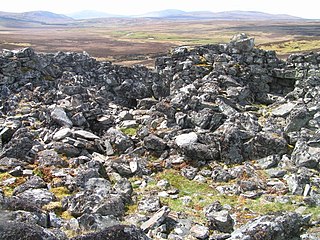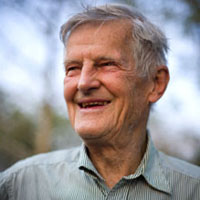Related Research Articles

Maeshowe is a Neolithic chambered cairn and passage grave situated on Mainland Orkney, Scotland. It was probably built around 2800 BC. In the archaeology of Scotland, it gives its name to the Maeshowe type of chambered cairn, which is limited to Orkney.

Skara Brae is a stone-built Neolithic settlement, located on the Bay of Skaill in the parish of Sandwick, on the west coast of Mainland, the largest island in the Orkney archipelago of Scotland. It consisted of ten clustered houses, made of flagstones, in earthen dams that provided support for the walls; the houses included stone hearths, beds, and cupboards. A primitive sewer system, with "toilets" and drains in each house, included water used to flush waste into a drain and out to the ocean.

The Ring of Brodgar is a Neolithic henge and stone circle about 6 miles north-east of Stromness on Mainland, the largest island in Orkney, Scotland. It is part of the UNESCO World Heritage Site known as the Heart of Neolithic Orkney.
Below are notable events in archaeology that occurred in 1890.
Below are notable events in archaeology that occurred in 1913.

Alfred Percival Maudslay was a British colonial administrator and archaeologist. He pioneered the careful archaeological study of the Maya ruins and the results of his field work were presented in Biologia Centrali-Americana: Archaeology (1889–1902). The massive five volume set continues to serve as an important work of reference for the study of Maya culture. In 1908, he made a complete translation, with annotations, of Bernal Díaz del Castillo's Historia. His translation remains the standard English edition.
The year 1972 in archaeology involved some significant events.
Below are notable events in archaeology that occurred in 1931.
Below are notable events in archaeology that occurred in 1924.
Below are notable events in archaeology that occurred in 1881.
Below are notable events in archaeology that occurred in 1927.
Below are notable events in archaeology that occurred in 1928.
Below are notable events in archaeology that occurred in 1930.

In archaeology, an Atlantic roundhouse is an Iron Age stone building found in the northern and western parts of mainland Scotland, the Northern Isles and the Hebrides.

Heart of Neolithic Orkney is a group of Neolithic monuments on the Mainland of the Orkney Islands, Scotland. The name was adopted by UNESCO when it proclaimed these sites as a World Heritage Site in December 1999.
Annie G. Hunter was an English professional artist and illustrator, best known for her reproduction drawings of pre-Columbian Maya monuments and inscriptions. In the late 1890s Hunter was commissioned by the early Mayanist scholar Alfred Maudslay to provide drawings and watercolored illustrations of Maya monuments. Her illustrations appeared in Maudlay's pioneering archaeological and iconographic survey Biologia Centrali-Americana: Archaeology.

The Ness of Brodgar is an archaeological site covering 2.5 hectares between the Ring of Brodgar and the Stones of Stenness in the Heart of Neolithic Orkney World Heritage Site on the main Island of Orkney, Scotland. The site was excavated from 2003 to 2024, when it was infilled due to concerns about damage to the structures exposed by excavation.

Ian James Alastair Graham OBE was a British Mayanist whose explorations of Maya ruins in the jungles of Mexico, Guatemala, and Belize helped establish the Corpus of Maya Hieroglyphic Inscriptions published by the Peabody Museum of Harvard University. Among his related works is a biography of an early predecessor, the 19th-century British Maya explorer Alfred Maudslay.

Rites of the Gods is an archaeological study of religious belief and ritual practices across prehistoric Britain from the Old Stone Age through to the Iron Age. Written by the prominent English archaeologist and megalithic specialist Aubrey Burl, it was first published in 1981 by J.M. Dent & Sons Ltd.
Margaret Eleanor Barbour Simpson, was a Scottish archaeologist. She is considered as the first professional woman archaeologist in Scotland. She was a member of V. Gordon Childe's team of archaeologists at Skara Brae and Kindrochat, as well as the writer of some of the first guidebooks for state-owned historic properties in Scotland.
References
- ↑ "Skara Brae Prehistoric Village". VisitScotland. Retrieved 18 May 2017.
- ↑ "Tara Brooch". museum.ie. Retrieved 18 May 2017.
- ↑ Merwin, Keith. "Alfred P. Maudslay". Institute of Maya Studies. Archived from the original on 13 March 2017. Retrieved 12 March 2017.